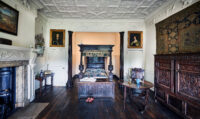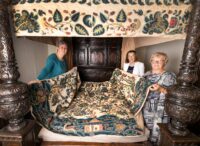 After 10 years of restoration, a set of 350-year-old embroidered bed hangings have returned to the bedroom in a Birmingham mansion where King Charles I slept in 1642. The conservation team included both professional conservators and volunteers who worked together at Birmingham Museums to clean and stabilize the rapidly decaying linen, repair holes and fix loose threads to new linen support fabric by stitching over them (couching).
After 10 years of restoration, a set of 350-year-old embroidered bed hangings have returned to the bedroom in a Birmingham mansion where King Charles I slept in 1642. The conservation team included both professional conservators and volunteers who worked together at Birmingham Museums to clean and stabilize the rapidly decaying linen, repair holes and fix loose threads to new linen support fabric by stitching over them (couching).
 The embroidered linens are in the collection of Aston Hall, a Jacobean mansion built by Sir Thomas Holte, 1st Baronet of Aston, between 1618 and 1635. King Charles honored the great house with his presence in October 1642, mere months after armed hostility with Parliamentarian had broken out. The king stopped at Aston Hall after levying troops at his temporary base in Shrewsbury, and on October 23rd, only days after the king left the comforts of Holte’s hospitality, he and the Royalist army faced the Parliamentarian army at the Battle of Edgehill, the first pitched battle of the First English Civil War.
The embroidered linens are in the collection of Aston Hall, a Jacobean mansion built by Sir Thomas Holte, 1st Baronet of Aston, between 1618 and 1635. King Charles honored the great house with his presence in October 1642, mere months after armed hostility with Parliamentarian had broken out. The king stopped at Aston Hall after levying troops at his temporary base in Shrewsbury, and on October 23rd, only days after the king left the comforts of Holte’s hospitality, he and the Royalist army faced the Parliamentarian army at the Battle of Edgehill, the first pitched battle of the First English Civil War.
Aston Hall was targeted directly by Parliamentarian forces in December 1643. It was subjected to cannon fire for three days before the defenders surrendered. There is still a cannonball hole in the wooden staircase.
The hangings weren’t on the bed when Charles drew Aston Hall into these momentous events. They date to the same period and hang on a bed that also dates to the same period.
Designed using a type of embroidery called crewel work, which was a particular favourite style of the Jacobean period, the embroidered bed hangings comprise two curtains, pelmets and a bed covering. They feature an exquisite Tree of Life pattern, flowers, birds, deer and a Chinese-style pavilion. The wool threads are coloured with natural dyes in shades of blue, green, yellow, orange, red and pink. Embroidered bed coverings were the preserve of only the wealthiest families in the 17th century and such sets of hangings around a bed, gave warmth and privacy.
Jane Thompson-Webb, Conservation Team Leader at Birmingham Museums said:
“It’s a major achievement welcoming these embroideries back on display at Aston Hall. Before the start of the restoration project, they were very dirty, the colours were dull, and it was obvious that the embroideries were in a fragile state and at risk of being lost forever.
“They’ve been superbly restored thanks to our dedicated team of volunteers – with their hard-work these historic embroideries and their fabulous colours, intricate scenes and delicate details have been preserved for many more years to come.”
Wow! This type of restoration cannot be accomplished except with the aid of volunteers. That was not exaggeration to say the linens were disintegrating. One can see the many tears and loss in the close-ups. Every stitch must be done by hand securing the backing fabric and the net stabilizer over the handwork. Was there any mention of who created the hangings? Thanks for posting this amazing restoration project.
I do embroidery and I cannot fathom how long it took to create those beauties. Well done to the restoration team!
@Emily….embroideries like this were generally done by the ladies of the household.
One of the requirements of an accomplished lady both in Elizabethan and Jacobean England was embroidery. A few pieces still exist sewn by the hands of Queens (Elizabeth I, Mary Tudor and Mary Queen of Scots) as well as innumerable pieces by Duchesses and ladies. Indeed Catherine of Aragon hand embroidered Henry VIII’s linen shirts with blackwork and redwork and boasted of her accomplishments in that area.
The designs themselves would most likely have been drawn onto the linen by an artist, just simple outlines, not coloured in.
Also ladies could buy folios of pattern motifs , the outlines of the thick paper patterns were then pricked with a needle, placed on the fabric and ‘pounce’ (charcoal in a small cotton bag) rubbed over the paper, the charcoal sifted through the pricked holes leaving a dotted line which would then be painted over to give the design. These ‘prickings’ could be used over and over again.
Many hours a day in wealthy households would have been devoted to embroidery and gossip
Professional work shops were almost exclusively dedicated to metal thread work and silk embroidery.
Thank you, Ambrosius, for the detailed explanation. The method for crewel work has not changed much in nearly five centuries. Although such needlework is only done now by hobbyists primarily, some finishing schools required fine embroidered pieces as proof of accomplishment as recently as one generation ago.
Mesh helps hold ruptured linen together too.
How were they hangings cleaned?